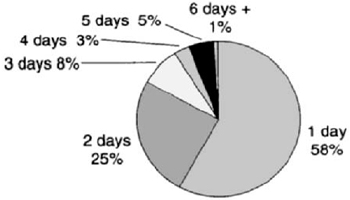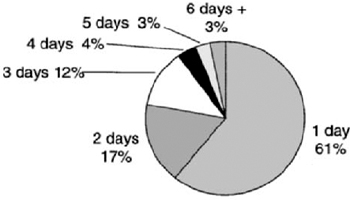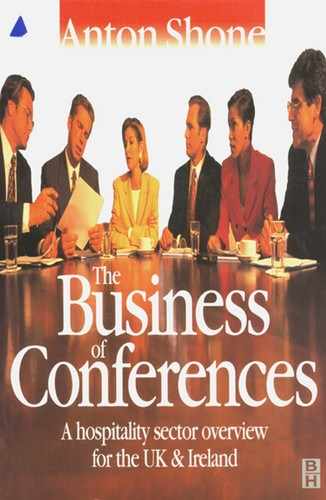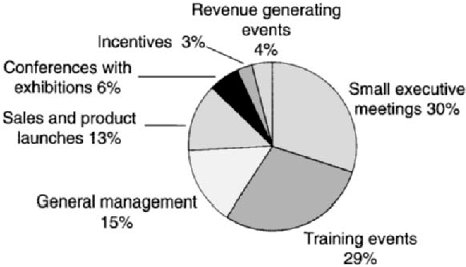2_______________________________________________________
The conference business and
its market demand____________________________________________
The aims of this chapter are
- 1 To define the term ‘conference’ and consider the reasons why conferences take place.
- 2 To identify and classify the major demand generators for the conference business, into two principal categories: Corporate and Association.
- 3 To consider the corporate market in terms of its principal components together with the organizational aspects of the conference booking process for corporate businesses.
- 4 To consider the association market in terms of its principal components together with organizational aspects of the conference booking process for associations.
- 5 To categorize meetings in terms of the type of meeting or event being held.
2.1 Introduction
In identifying and analysing markets it is common to segment the whole. This categorization enables a closer examination of the component parts of the market. The demand generators for the conference business can be most conveniently categorized into the corporate market and the association market, or, roughly, profit-making and non-profit-making organizations. Later, it will be possible to see the importance of this categorization as an issue of targeting, by venue managements, of particular segments of these respective categories. In some respects the categorization is rather unusual compared to the way in which we might, for example, segment the market for hotels. With this latter it is often possible to identify individuals and classify according to age, reading patterns, social outlook and so on, thus enabling very specific sales or advertising tools to be used. With the conference business, we are dealing at an organizational level rather than an individual level. This organizational level has a number of implications for the use of sales or advertising tools and the approach of conference sales teams promoting their venues.
The corporate market tends to receive far more attention from venue managers than the association market. This is almost certainly due to a perceived relatively high average spend and perceived greater likelihood of repeat business. It is also likely that conference venues are more able to assess their chief potential corporate clients within a particular catchment area than is the case with the association market, some of which is voluntary and in which organizations’ volunteer organizers may be extremely transient. There is also an evident difference of approach, for corporate clients rely increasingly on both internal and external agents to organize their conferences, and have the funding to do so, as well as pay for their own delegates (i.e. company employees) to attend. On the other hand the association client is more likely to be a volunteer with little or no experience of conference organization and needing greater levels of assistance from the venue.
2.2 What is a conference and why is it needed?
The Meetings Industry Association (1996) defines a conference as ‘An event involving 10 or more people for a minimum of four hours during one day or more, frequently held outside the company’s (sic) own premises’. However, this definition is rather prescriptive. Figure 2.1 illustrates the wider range of purposes for which conferences meet. There are also the more generalized functions of a conference, such as providing a vehicle to network with colleagues and, perhaps, as a vehicle to explore hidden agendas. Montgomery and Strick (1995), highlighting this, also make the point that corporations and associations have slightly differing needs for meetings: corporations may require meetings to disseminate information, plan, solve problems and train people; associations may require meetings more primarily for networking, education of members, planning and problem solving, and also to generate revenue.
Conferences serve one or more of the following purposes:
• Provide a forum for the generation and exchange of information and ideas.
• Enhance communication by creating a pool of shared knowledge (and values).
• Generate a spirit of unity and co-operation that may contribute to the formulation of a collective identity and the recognition of participants.
• Afford the management or the senior members of an organization an opportunity to define and promote the collective aim of the organization and provide a setting in which senior members of the organization can visibly act as leaders.
• Obtain commitment to decisions by involving more individuals in the decision-making process, thus contributing towards a common goal.
• Enable participants to network and socialize with others during the event, thus contributing to the exchange of information and the social development of an organization at an informal level.
• Provide an opportunity for the exploration of hidden agendas, which might not otherwise be possible in the formal work environment.
Adapted from Woods and Berger, 1998
Figure 2.1
Conferences normally, but not exclusively, involve meeting in a given location with subsidiary activities such as the consumption of food and drink and the use of technical facilities. In both cases conference venues are exploiting one further need - the need to take staff or members out of their usual environment: where pressure of work may reduce the time available for meetings, where there may be constant interruptions or where the organization may simply not have the space to hold the meeting.
2.3 The identification of markets and demand
generators
A great deal of conference activity is business related, but not exclusively so, as conferences involve not only commercial organizations, but also voluntary and non-corporate bodies. It is axiomatic of the conference business that the market can be classified into two general categories: first, corporate demand, secondly, association demand (Astroff and Abbey, 1985). In many surveys of the conference business, and in the view of a number of venue managers, it is the corporate market that is by far the more significant; however, such a view tends to reflect the ability of the corporate market to spend a larger sum on the organization of a particular conference. To concentrate on the corporate market alone would present an unbalanced view of the way in which demand is generated by various organizations. Indeed the Coopers and Lybrand Deloitte survey (1990) appears to make this very mistake, identifying sources of conference demand as being almost entirely corporate.
For the purpose of the analysis of demand generators, the classification into corporate and association demand will suffice, with the proviso that not all organizations, or all conference activities, will necessarily conveniently fit into these respective classifications. It should also be borne in mind that the sources of demand for a given conference centre or conference hotel in a particular location will be unlike the generalized pattern being discussed. Although some venues, such as the International Convention Centre (ICC) in Birmingham, may have a market catchment which ranges from the local to the international, a typical conference venue will be predominantly dependent on local sources of demand, be those local companies or other local organizations. The feasibility study of any new conference venue must therefore take great care to assess demand which is not only within a given catchment, but which could also be drawn away from competitor venues.
2.4 The corporate market
The corporate market is considered to be the largest demand generator in terms of income by the conference industry, though there is little research evidence at present to support the claim, merely the anecdotal views of venue managers. This is partly due to a lack of adequate analysis of demand and an inability to classify demand accurately. While venue managers are commonly able to say ‘Company X is our largest corporate customer’, it is rarer for venue managers also to be able to add ‘forming X per cent of our total business’. The interpretation, used here, of corporate business is that the organization concerned should be profit making: public and private companies; the locally based small business, whether publicly or privately owned; and similar organizations.
The corporate market varies in its propensity to use conference venues, as certain types of organizations require the exchange of information (for management, sales, training or research) more frequently than others. Only the European Incentive Travel Survey (Touche Ross, 1990) attempted to classify key generators in the corporate sector; it nevertheless gives the only research overview of such demand. Respondents to that survey are shown by industry sector in Table 2.1. Such data must, however, be taken with a pinch of salt. Each conference venue could analyse not only its own existing business base, but also the industry composition of its own town, city or region, to highlight areas of demand. Analyses of this type would paint a far more accurate picture of a location’s corporate demand than do the above figures. There is also a related issue of ‘catchment area’. The Coopers and Lybrand Deloitte survey indicates that location is of serious importance to demand generators (or put more simply, conference organizers). About 70 per cent of organizers felt that a venue needed to be close to a motorway, but also, significantly, 50 per cent of organizers felt that venues needed to be both within one hour of a major city and within one hour of a major airport. These comments help to delineate the boundaries of the catchment of a conference venue and help to explain why regions such as East Anglia, with relatively poor transport networks and relatively poor provision, may fail to attract significant conference business.
Table 2.1 Corporate market demand - industry respondents
| Pharmaceuticals | 10% |
| Financial and insurance | 10% |
| Cars | 10% |
| Automotive parts | 9% |
| Computing | 9% |
| Toiletries/Cosmetics | 9% |
| Electronics | 9% |
| Electrical appliances | 7% |
| Office equipment | 6% |
| Agricultural equipment | 5% |
| Retailers | 5% |
| Building materials | 5% |
| Heating/Air conditioning | 4% |
| Leisure/Catering | 1% |
| All others | 2% |
Source: Touche Ross (EITS 1990)
A further aspect in assessing the corporate market is the issue of who would typically book a conference for an organization. This is a more significant question for the corporate market than the association market for reasons which will be explained later. Up until ten years ago, in the UK, the majority of corporate conferences were organized internally, by a manager or secretary within the organization. However, the downsizing of companies has seen a greater need to contract out activities, of which conference organization is one. Currently about half the corporate market is probably dealt with in-company (Coopers and Lybrand Deloitte, 1990), either directly by the company management or its support staff, or by a servicing department doing it on behalf of another division of the company. It is significant for the conference venue to know who, within the company requiring the conference, holds the budget for it. Of the remainder, conference placement agents account for about a quarter of corporate bookings. Quite simply, placement agents operate in very much the same way as any other agency activity; for a suitable commission they will make the link between venue and corporate client without the client having to become unduly involved in venue choice and arrangements.
In addition there are various types of ‘middlemen’. There are, for example, an increasing number of conference production companies; such companies are particularly important where an organization requires highly technical or specialist services. A product launch would be a good example, there being a need for relatively complex visual and operational backup, above and beyond that required for, say, a basic training conference. Incentive travel companies are also involved in the conference business and fulfil an agency-type role where an organization needs to arrange not only a conference, say of its chief executives, but also some elements of travel, entertainment or perks required as a reward for good service or a prize-winning effort of staff within an organization.
A further aspect of the commercial market is the conference management companies which have a specific role in providing a service out of which they generate not a commission, but a profit. Typical examples are those companies providing training seminars in such subjects as information technology, human resources management, financial issues or sales training. These companies sell places at seminars or conferences to a wide range of organizations which may be too small or whose needs are too diverse for them to provide these services themselves. Companies of this kind, providing ‘walk in’ type conferences, meetings and seminars, will use a range of venues ranging from deluxe hotels to educational establishments, depending on the type of delegate and subject.
The corporate market has a known pattern of demand for the length of conferences. This pattern of demand has been identified in a number of surveys, including that reported by Richards (1996) for the English Tourist Board and shown in Figure 2.2.

Source: Richards, 1996
Figure 2.2 Length of conference in the corporate market
2.5 The association market
Unlike the corporate market, the association market has received virtually no research attention and is, therefore, almost impossible to quantify, even anecdotally. Nevertheless the association market is extremely significant, and also extremely diverse. The interpretation used here of association business is that the organizations concerned are likely to be (though not exclusively) non-profit making. This interpretation allows us to take in an extremely wide range of organizations, some of which are run by salaried staff, some of which are run entirely by unpaid volunteers, and some of which may be governmental or quasi-governmental. The diversity of the association market is one reason why it is difficult to classify; a further reason is the concentration of venue managers on the corporate market, which is perceived, to a certain extent possibly wrongly, to be more profitable for venues. Nevertheless, the association market can be broadly split into professional associations on the one hand, and voluntary associations on the other.
The association market varies in its propensity to use conference venues as much as the corporate market, and for much the same reasons: a variety of organizational needs, differing management requirements and the extent to which information needs to be exchanged. Crucially, however, many of the organizations involved in the association market do not fund their own conference activity, but must charge their delegates the direct costs of doing so. This ensures that the association market is likely to be more price sensitive, having a propensity to choose venues such as educational establishments and municipal centres, but also that price sensitivity may determine location more significantly than is the case with the business market. As with the corporate market, there is a known pattern of demand in terms of length of conferences, which can be seen in Figure 2.3. There has been no detailed survey of the association market structure; consequently it is impossible to rank the importance of the various component organizations in any realistic way. Nevertheless the range of component organizations is significant and deserves elaboration.

Source: Richards, 1996
Figure 2.3 Length of conference in the association market
Professional associations
This division includes trade, professional, scientific and technical associations, also national public associations, military associations and industrial bodies. Professional associations also comprise:
- • Government and agencies This category includes national government bodies, local government bodies, chambers of commerce and agencies such as English Heritage and so on.
- • Trade unions and political parties This category, self-evidently, contains not only all the political parties but also the TUC and its member unions.
Voluntary associations
This division includes organizations such as rotary clubs, the Lions, alumni societies, school groups and Womens’ Institutes. Voluntary associations also comprise special interest groups such as sports clubs, hobby and craft clubs, lobbying groups, pressure groups and any organization with a closely defined purpose (e.g. a gardener’s club):
- • Youth groups This category includes youth clubs, organizations such as the YMCA or the Youth Hostelling Association, scouts and guides.
- • Voluntary and charitable bodies A wide range of organizations ranging from charities such as ‘Save the Children’ to bodies such as the National Trust.
- • Religious groups Including a wide variety of religious denominations and interest groups, church bodies and organizations such as the Salvation Army.
In much the same way as a conference venue could assess the corporate market in its catchment area, the same could be done for the association market. However, the process is rather more problematic. While the extent of the corporate business market may be obvious from such publications as a city or chamber of commerce guide, or an astute survey of the Yellow Pages, identification of the association market within a given catchment is limited because of the diversity and ad hoc nature of the organizations involved. Indeed many of the organizations within the voluntary association market may not even have a public phone number, central office or secretary. Assessment of this market will require a careful analysis of past data, monitoring of competitors’ business and assiduous record keeping about the local community.
The organization of conferences for the association market relies much less on agencies and production companies, and a great deal more on the efforts of often unpaid volunteers. This poses a challenge for venue managers and sales teams, not only in identifying who, in an association, is likely to be the conference organizer, but also in terms of dealing with organizers who lack the necessary experience and skills. In consequence sales teams may have to exert greater efforts to ensure an association conference goes smoothly than might be the case when dealing with a more experienced placement agent or a contact within a commercial organization whose specific duties include conference organization.
2.6 Types of conference
In addition to categorizing, or segmenting, demand generators, it is also possible to consider the conference business in terms of the purpose for which the conference is being organized. The most common range of purposes are summarized in Figure 2.4, and include the following.
Small executive meetings
This type of conference, in which the number of delegates is usually less than 20, is the largest single category. It is a type which is particularly suited to hotel conference venues, and is especially important to the country house hotel sector. These meetings are usually fulfilling a managerial, planning or problem solving role.
Training events
This type of conference normally varies in size from the more common smaller event, again with fewer than 20 people, to some quite large ‘educational’ training events of up to 200 people. The events are again suited to the hotel sector, though with a tendency to concentrate more on city or regional locations (or those associated with company head offices, divisional offices, and management training centres).
Source: Coopers and Lybrand Deloitte, 1990
Figure 2.4 Segmentation by type of conference
General management
This type of conference, including everything from routine management to Annual General Meetings, has expanded significantly due to the increase in company restructuring taking place and the need to discuss and inform an organization about changes in management or policy. Meetings normally range from the small to the relatively large - 300 or so is a common figure. While hotel conference venues are important, the larger events in this category begin to use purpose-built venues.
Sales and product launches
This type of event probably involves not only a conference but also an exhibition as the raison d’être of the event. Such launches are generally large affairs and require not only extensive organizational effort but also significant technical facilities. Events of this type are most common in purpose-built venues. Indeed there is some evidence to indicate a shortage of the largest type of venues for these events (Law, 1993). In terms of the sales conference (or exhibition involving a corporate dealership), large venues are required and also probably some element of incentive, thus dealership conferences and exhibitions may take place in more specialist or unique venues.
Conferences with exhibitions and trade fairs
An extremely large segment of the business, estimated to have an exhibition expenditure, in 1993, of some £740 million (Keynote, 1994), ranging from the very small, such as an art show, to the very large such as a boat or home show. Purpose-built venues are often used, though hotels and a wide range of other venues are also able to provide suitable space and adjacent conference facilities.
Incentive conferences
While it can be argued that most conferences have the incentive of ‘uniqueness’ away from the daily routine of commercial or organizational life, there is a demand for conferences which have an overt incentive package, involving some aspects of travel/tourism or special event as part of the conference. The Touché-Ross European Incentive Travel Survey 1990 looked at this business in some detail and concluded that it was a particularly lucrative part of the market, tending to use both deluxe hotel venues and also unique venues as part of the package.
Revenue generation events
Both for associations and for conference management companies, revenue generation is a significant part of organizing a conference. Events of this kind are often educational or informative but contribute to the organizer’s financial viability. Conferences or meetings of this kind are often held in universities or colleges or small hotel locations to keep costs down.
Summary
Conferences, large and small, exist as a means of exchanging information and as a forum for many related inter-social activities. There are many sources of demand for conferences, but we have, for convenience, categorized them in two ways: first, by market origin into corporate and association markets, then into various subdivisions; secondly, by the type of conference itself.
References
Astroff, M.T. and Abbey, J.R. (1985) Convention Sales and Services, New Jersey, Waterbury Press, pp. 69–110.
Coopers and Lybrand Deloitte (1990) UK Conference Market Survey 1990, London, Coopers and Lybrand Deloitte Tourism and Leisure Consultancy Services, pp. 7–13.
Cotterell, P. (1994) Conferences: An Organizer’s Guide, Sevenoaks, Hodder and Stoughton, pp. 1–12.
Keynote Reports (1994) Keynote Report, A Market Sector Overview: Exhibitions & Conferences, London, Keynote Publications, pp. 29–32.
Law, CM. (1993) Urban Tourism, London, Mansell, pp. 39–68.
Meetings Industry Association (1996) UK Conference Market Survey 1996, Broadway, Meetings Industry Association, pp. 1–32.
Montgomery, R.J. and Strick, S.K. (1995) Meetings, Conventions and Expositions, New York, Van Nostrand Reinhold, pp. 66–64.
Richards, B. (1996) The conference market in the UK. In Insights, London, English Tourist Board, pp. B-67-B-83.
Touche Ross (1990) The European Incentive Travel Survey 1990, London, Touche Ross, pp. 100–102.
Woods, R.H. and Berger, F. (1988) Making Meetings Work. Cornell Hotel and Restaurant Quarterly, 29, pp. 101–105.

